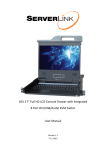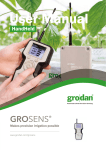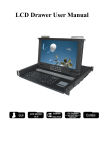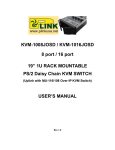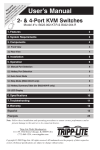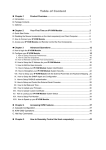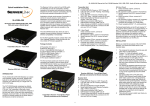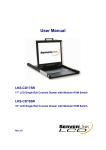Download 1RU 17” & 19” LCD Console Drawer with Integrated KVM
Transcript
1RU 17” & 19” LCD Console Drawer with Integrated KVM Switch ‐ Single Port / 8 Port / 16 Port Optional Remote IP Access User Manual Version 2.0.1 29‐03‐2013 Contents 1. BRIEF INTRODUCTION ……………….……………………………………………….………………………..... 3 2. 3. 4. 5. 6. 7. PACKAGE CONTENTS …………………………….…………………………………………….…..……………… 3 FEATURES …………………………………………………..……….………………………………..………………… 3 SPECIFICATIONS ………………………………………………………………………..……………………………. 4 INSTALLATION ………………………………………………..………………………………………………………. 6 OPERATION ....……………...…………………………………………………...………….……….………….….. 9 CERTIFICATIONS………...………………….....………….………………………………….…….…………….. 16 2 BRIEF INTRODUCTION The ServerLink single port, 8 port and 16 port LCD Console Drawers can control attached servers, computers or a KVM switch from a local or remote console. The 8 port & 16 port models are loaded with features such as an optional IP based remote console port, On‐Screen‐Display (OSD) menu, password security, Hotkey control, push button port selection and auto scan control. It has complete keyboard and mouse emulation for simultaneous and flawless PC boot‐up process. With the optional IP based remote console port you can control connected servers locally at the rack or remotely via the Internet using a standard browser. You can securely gain BIOS level access to systems for maintenance, support or failure recovery over the Internet. Communication is secure via SSL encryption. PACKAGE CONTENTS 1 x ServerLink LCD Console Drawer with Rack Mounting Sliding Rails 1 x AC Power Cable 1 x Set of VGA, USB and PS/2 cables (Single Port LCD Console Drawer models only) 1 x CD‐ROM with User Manuals, Quick Installation Guides and Utilities 1 x Quick Installation Guide FEATURES Supports combo (PS/2 & USB) interface for connecting to computer ports or KVM switch One optional remote console port (Insertion Card : IP Module – 8 & 16 port models only) Supports MS Windows, Netware, Unix and Linux Supports Mac, Power Mac and Sun Micro Systems with USB connection No Software Required ‐ easy computer selection via On‐Screen‐Display (OSD) menu, push buttons or keyboard Hotkeys Provides various Hotkey combinations (Caps‐Lock / Scroll‐Lock / Num‐Lock / L‐Alt / L‐Ctrl / L‐Win / R‐Alt / R‐Ctrl / R‐Win) for switching between computer ports and other control functions Provides ACL (Access Control List) security function and stores up to 8 independent user accounts Hot Plug ‐ add or remove connected computers without powering off the LCD drawer Supports two user layers and search computer/server name Keyboard status restored when switching between computers Supports daisy chain (8‐layer) & cascade (2‐layer) function 3 SPECIFICATIONS Feature Specifications Computer Type Combo (PS/2 & USB Support) Computer Port Connector HD15 Pin (Integrated video, keyboard & mouse) No. of Computer Ports 1 / 8 / 16 Maximum Distance (LCD Drawer to Comp) 5 metres LCD Resolution 1280 x 1024 Video Resolution (Remote Console) 1600 x 1200 for IP‐Based remote console Over IP ‐Based (Optional) Remote Module RJ45 for 10/100 Ethernet DB9 male for modem, null modem and serial power control USB 2.0 Mini B female Daisy Chaining Supports Daisy Chain (Bus layer to 8 levels) & (Tree layer to 2 levels) Computer port selection On Screen Display (OSD) Menu, Hot Key, Push Button Hotkey Provides various Hotkey Combinations (Cap‐Lock / Scroll‐Lock / Num‐Lock / L‐Alt / L‐Ctrl / L‐Win / R‐Alt / R‐Ctrl / R‐Win) LEDs Power On & Port Selection Security Provides ACL (Access Control List) security function and stores up to 8 independent controllable computers lists Multilingual OSD (On Screen Display) control 8 Languages (English, France, German, Spanish, Italian, Russian, Japanese and Simplified Chinese) Auto‐Scan Intervals 5 ~ 99 Sec Keyboard Emulation PS/2 or USB Mouse Emulation PS/2 or USB Max. Comp. Connections 1024 Housing Metal Operation Temperature 0 ~ 50Ԩ Storage Temperature ‐20 ~ 60Ԩ Humidity 0~95%, Non‐Condensing Mechanical 1RU 19” Rack Mount Power AC 100‐240V AC 50/60Hz Dimension (mm) 450 (W) x 600 (D) x 44 (H) 4 LCD Drawer Front VIEW To add a remote IP console module, remove this plate 8 port LCD Drawer Rear VIEW 16 port LCD Drawer Connection Diagram 5 INSTALLATION Step 1 Loosen screw A on both sides to slide out and remove the two rear slide rails. Remove safety stopper B by loosening the two screws and moving to unlock position. Rear Slide Rails Step 2 Attach the two rear slide rails to the rear vertical mounting rails of the rack cabinet using standard M6 cage nuts and screws. Rear Cabinet Rails Step 3 Position the LCD console drawer so the two rear slide rails will slide into the main body of the LCD console drawer. Attach the mounting ears of the LCD console drawer to the front vertical mounting rails of the rack cabinet using standard M6 cage nuts and screws. 6 Single Port LCD Console Drawer To connect to a KVM switch with PS/2 inputs or a single computer with PS/2 inputs, use the supplied 3‐in‐1 VGA & PS/2 combo cable. To connect to a KVM switch with USB inputs or a single computer via its USB port, use the supplied USB type A to USB type A cable. Connect the VGA port using the supplied 3‐in‐1 VGA & PS/2 combo cable. Do not connect the PS/2 connectors. LCD Console Drawer with 8 or 16 Port KVM On the back of the 8 or 16 port KVM Switch, each of the computer ports has an HD15 pin female connector. This single HD15 pin connector integrates all VGA, USB & PS/2 signals. The USB cable has a 2‐in‐1 connector at one end and the PS/2 cable has a 3‐in‐1 connector at one end. Both the USB cable and the PS/2 cable have a single HD15 pin male connector at the other end. Plug the single connector end of the cable into the KVM and the other end of the cable into the computer’s 15 pin VGA port. 2‐in‐1 VGA & USB Combo Cable (a) PS/2 computer ‐ Plug in the PS/2 mouse connector to the computer mouse port and the PS/2 keyboard connector to the computer keyboard port. 3‐in‐1 VGA & PS/2 Combo Cable (b) USB computer ‐ Plug in the USB connector to the computer’s USB port. This single USB connector can handle both keyboard and mouse data. Optional 2nd Console Module Installation Remote IP Module Please refer to the “ServerLink IP Module User Manual” on CD‐Rom for detailed setup and operation. Installation: Power off the LCD drawer. Remove the cover of the add‐on slot, slide in the Remote IP Module and make sure the module is fully inserted into the slot. Serial Power Control 7 The Remote IP Module comes with a serial port for connecting to any serial device, such as a serial PDU to provide remote power control, such as power on, power off and power cycling of the connected computers/servers. Optional IP Module Diagram Daisy Chain Connection You will need to purchase the optional daisy chain cable. Use one end of the daisy chain cable to connect to the Daisy Chain port of the Master KVM switch and connect the other end of daisy chain cable to the Local Console port of the next Slave KVM switch. Please repeat the connection procedures for next Slave KVM switch. You can daisy chain up to a maximum of eight (8) banks. Daisy Chain Connection The On‐Screen‐Display (OSD) menu will display the port information of the master KVM switch. When the master unit starts up, it will query all daisy chained Slave units and automatically set up the Bank ID for each 8 Slave unit. Hot Plug function is supported through daisy chain connection. The Master unit will auto‐query the daisy chained Slaves every 30 seconds. You can also daisy chain through any computer port on the KVM switch. This daisy chain method will work with any brand of KVM switch. Please note, you need to change the Hotkey of the slave KVM switches so that the master and slave KVM switches do not use the same Hotkey. Daisy Chain through any Computer Port OPERATION Push Button Port Selection The most convenient way to switch between computers is via the push buttons on the LCD console drawer. To select a computer, simply push the corresponding button. Ports with a powered on computer connected have a Red LED. The currently selected port has a Green LED. Hotkey You can conveniently control the LCD console drawer through simple keyboard Hotkey sequences. To send keyboard Hotkey commands to the LCD drawer, you must press the Hotkey (default Hotkey is Caps Lock + Caps Lock) within 2 seconds. You will hear a beep sound confirming you are entering the Hotkey mode. If you do not press any key during Hotkey mode within 2 seconds, the Hotkey mode will be disabled and return the keyboard back to its normal state. The default Hotkey is Caps Lock + Caps Lock but you can change the Hotkey to an alternate Hotkey if Caps Lock clashes with any existing applications. To change the Hotkey, please go to the OSD menu. 9 The default Hotkey is Caps Lock + Caps Lock, then the keys on the following table list. Command Space bar Function Brings up the On‐Screen‐Display (OSD) window ↑ Switches to the previous port ↓ Switches to the next port ■ The first digit is the KVM Switch bank number in the daisy chain line. A standalone KVM switch is on bank 1 [01, 02…16] port ■ The second & third digits are the KVM switch port numbers starting with “01” [1, 2...8] bank, PgUp Switches to the previous bank PgDn Switches to the next bank B Turns the beep sound on/off R For SUPERVISORS, this will set the OSD back to the factory default values (except the User Security settings) S For SUPERVISORS, this activates the Auto‐Scan function U For SUPERVISORS, this turns the Security function on/off. (Default is Off) P Log out ‐ only valid when the security function is on Example 1 – To bring up the OSD window, press Caps Lock + Caps Lock + Space Bar The OSD overlay screen will appear. This overlay menu screen is generated by the LCD drawer and does not affect your computer hardware or software function in any way. CAPS LOCK CAPS LOCK Enter Space Bar key within 2 seconds of the Hotkey sequence SPACE BAR Example 2 – To switch to Bank 1 Port 1, press Caps Lock + Caps Lock and 1 + 0 + 1 Enter 1+0+1 keys CAPS CAPS within 2 seconds of 1 0 1 LOCK LOCK the Hotkey sequence There are two methods to bring up the OSD overlay window. 1. Activate OSD by using Hotkeys ‐ press Hotkey twice then press Space bar. 2. Activate OSD by using your Mouse ‐ Press and hold the left button of the mouse and hit the Esc key to show the Status screen. Press and hold the right button of the mouse and hit the Esc key to bring up the Main Menu. 10 On‐Screen‐Display (OSD) The OSD menu provides a menu‐driven interface to control the LCD KVM switch. This OSD menu has four different display screens: 1. Login Window ‐ If the security function is enabled, when powering on the LCD KVM switch, a login window will be displayed and you will be prompted for the username and password. This OSD function can setup one SUPERVISOR and up to eight USERs. SUPERVISOR can access all OSD functions. USER can access only port switching and port search functions. 2. Status Screen ‐ The Status screen will be displayed and show the current port settings and Hotkey type. 3. Port Name ‐ This menu displays the port status and allows switching between ports. 4. Main Menu ‐ There are eight sub‐menus to operate. Login Window If the security function is enabled (default is disabled), when powering on the LCD KVM switch, a login window will be displayed and you will be prompted for the username and password. The Login Window The default account is SUPERVISOR Default username is eight zeros ‐ 00000000 Default password is eight zeros ‐ 00000000 The username and password are NOT case sensitive ‐ the OSD will display in upper case. Status Screen After login or port switch by push button, OSD or Hotkey, the Status screen will show up to display the information of current settings ‐ one digit BANK NUMBER, two digit PORT NUMBER, PORT NAME and current Hotkey setting. Pressing any key or moving the mouse will make the Status screen disappear immediately. The selected port no. The port name The selected bank no. The Status Screen The selected Hotkey 11 AUTO‐LOGOUT function At the Login window, if there is no input for the username and password for over 1 minute, the screen will disappear. Hit any key to bring up the Login window again. During normal operation, if there is no input from the keyboard or mouse for over 10 minutes, the LCD console will turn off the screen and show the Login window prompting for username and password. One more minute of keyboard/mouse inactivity and the monitor will turn off. Port Name Selected Bank Selected Port More Functions User Level Auto‐Scan Interval OSD Function Key Firmware Version Description F1 Go to the Main Menu F2 To log out of OSD. If Security function is enabled, it will show the Login window waiting for username and password. If Security function is disabled it will show up the Status window F3 Previous Menu Enter Switch to the selected port ↑ / ↓ Select the port (press Enter to switch) PgUp Previous Bank PgDn Next Bank Esc Exit 1 Show ports 01 ~ 08 2 Show ports 09 ~ 16 3 Show ports 17 ~ 24 12 4 Show ports 25 ~ 32 ■ USER ‐ There are two types of user levels: SUPERVISOR and USER. The default is SUPERVISOR. SUPERVISOR can setup and change the OSD settings in the Main Menu. USER can access only port switching and port search functions. ■ SCAN TIME ‐ This is the time interval for the auto‐scan function. When the auto‐scan function is enabled, the KVM switch will auto‐scan the computer ports one by one. Please note, any ports without a powered on computer/server will be skipped during the scan. ■ While the OSD is activated, the numeric keypad is not supported. Supported keys are the numeric keys across the top of the keyboard, the arrow keys, PgUp, PgDn and the Enter key. Main Menu There are eight sub‐menus to choose from. Language The OSD supports eight languages: English, French, German, Italian, Spanish, Simplified Chinese, Japanese, and Russian. The default language is ENGLISH. Move the cursor by keyboard (Up Arrow key or the Down Arrow key ) or mouse to select your preferred language. 13 Port Name Edit The first line of the menu is the Bank number. The following lines are the list of port names. Use the keyboard (Up Arrow key , Down Arrow key ) or mouse to select the port. After selecting the port, press the Enter Key to edit the port name. Press the Esc key to cancel the editing without any changes or press the Enter key to save your changes. Press the PgUp key or PgDn key for selecting the previous or next Bank. Port Search Search for a computer by port name. Using the “*” will show the all the port names. User Security There are two types of user levels: SUPERVISOR and USER. SUPERVISOR can access all OSD functions. USER can access only port switching and port search functions. You can have only one SUPERVISOR and up to eight USERs. Press the Enter key or right mouse button for editing. The “S” in the left column indicates SUPERVISOR, and “1…..8” indicates USERs. The maximum length for both NAME and PASSWORD is eight characters (A~Z and 0~9). NAME and PASSWORD are not case sensitive. 14 Access List Only the SUPERVISOR can configure the ACCESS LIST. The first column is the port number, followed by the server/computer name list. The last 8 columns are the access rights of each user. Use the Enter key or left mouse button to enable/disable the access rights of each port. “O” means to enable access and “X” means to disable access. Hotkey The default Hotkey is Caps Lock + Caps Lock but you can change the Hotkey to an alternate Hotkey if Caps Lock clashes with any existing applications. Time Settings This is the time interval for the auto‐scan function. When the auto‐scan function is enabled, the KVM switch will auto‐scan the computer ports one by one. Please note, any ports without a powered on computer/server will be skipped during the scan. The interval range is 5 ~ 99 seconds and the default interval is 10 seconds. Press the Enter key to save the SCAN TIME setting. 15 OSD Mouse You can change the movement speed of the OSD mouse cursor in this menu. There are three speeds to choose from, “FAST”, “MIDDLE” and “SLOW”. Use the and keys on the keyboard to move the highlight bar to the desired speed. Press the Enter key to go into effect. CERTIFICATIONS FCC This equipment has been tested and found to comply with Part 15 of the FCC Rules. Operation is subject to the following two conditions: (1) This device may not cause harmful interference (2) This device must accept any interference received. Include interference that may cause undesired operation. CE This equipment is in compliance with the requirements of the following regulations: EN 55 022: CLASS B. C‐Tick This equipment is in compliance with ACMA’s Electromagnetic Compatibility (EMC) regulatory arrangements under the Radiocommunications Act 1992. RoHS All contents of this package, including products, packing materials and documentation comply with RoHS. Trademarks All companies, brand names and product names referred to in this manual are the trademarks or registered trademarks belonging to their respective owners. 16





















